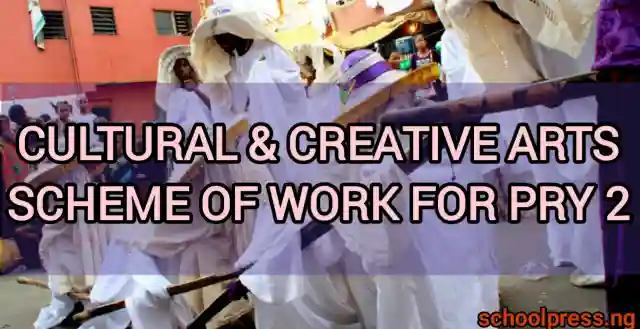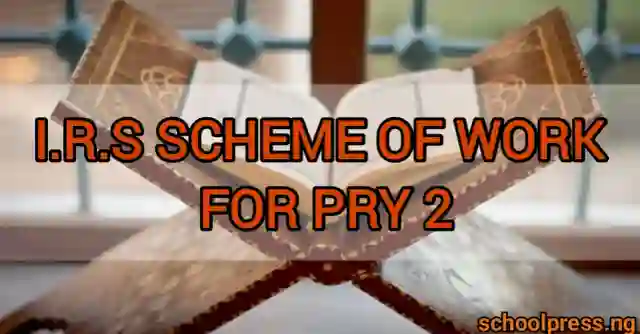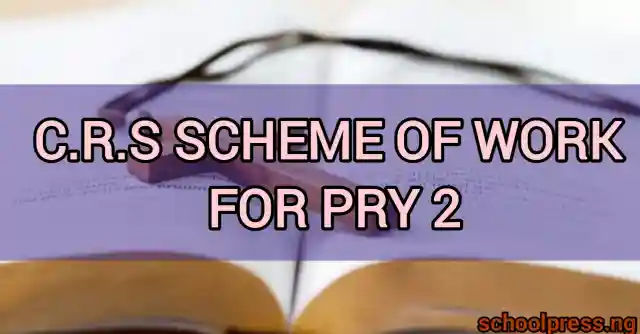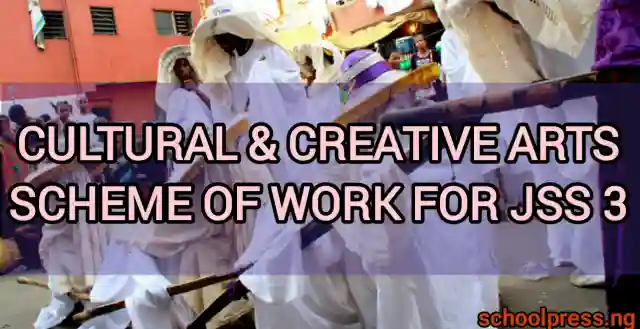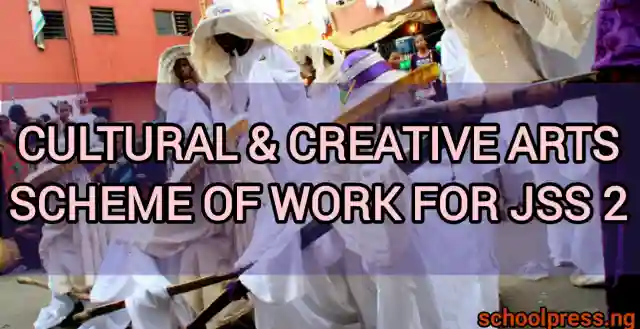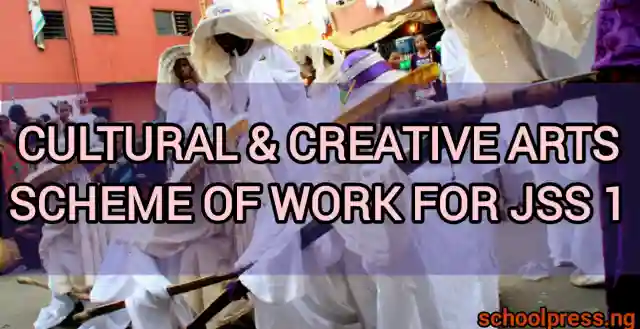The older pupils are, the more experience they need to be exposed to the form of art’s approach to culture. The Cultural And Creative Art Scheme of Work for Primary 2 is developed specifically for this goal.
The scheme of work presupposes lessons for pupils at the age of 5-6 years old to introduce them to certain cultural issues through several approaches to art, such as creation, drawing, singing, dancing, and storytelling.
The scheme of work is divided into three terms, and there are different objectives and learning outcomes in each term. The pupils are introduced to the shapes, sizes, functional artwork, traditional songs, dances, and festivals in the first term .
At this term, the pupils are trained how to identify the various shapes and sizes of objects, how to draw functional artwork, and use various colors as well as learn the traditional songs, dance, and festivals which are part of their culture.
During the second term, students are generally introduced to the following concepts; types of crafts, basic shapes, patterns, and melodies. Specifically, they are taught how to describe materials for craft making and design patterns using simple patterns and materials . They also learn how to identify various shapes and make patterns using similar shapes . Moreover, they are introduced to how to identify the melody of a given song and sing it using Tonic Solfa notation and clap to it
During the third term, pupils will be expected to learn:- Paper finding from books and magazines. Art and design creative works and decorations Motif, colors and their preparation Storytelling Traditional festivals Identify:- . A wide range of paper craft . Paper craft for play or decoration .
Different kinds of motif drawn . Produce simple pattern using motif Play:- A role of own choice among the characters in the story A role of a storyteller List the important important values learnt from their traditional festivals
To meet these learning outcomes, the scheme of work should be implemented by teachers. This can be done through teaching resources of real objects in various shapes and sizes, pictures of objects, drawings, audio, and video recordings of traditional songs, dances, and festivals.
Objectives of the Cultural And Creative Art Scheme of Work for Primary 2
First Term Objectives
Week 1-2: Explain the meaning of shapes and Identify different shapes and sizes of objects
Week 3: Draw shapes and sizes of objects
Week 4-6: Draw two different functional
Artwork and Apply different colours to each of the drawings.
Week 8: Identify the folk songs in their languages and Perform a local/traditional song in unison (i.e one-part singing)
Week 9: Identify and explain a traditional dance, Watch a video of a traditional dance and Perform a specified traditional/cultural dance
Week 10: Identify the different traditional festivals
Second Term Objectives
Week 1-3: Identify more types of Craft and Identify materials for craft making.
Week 4-6: Design simple patterns using basic shapes, Draw basic shapes e.g. circles and Make patterns using different shapes
Week 8: Explain melodic patterns, Identify the melody of a specified song, Sing a simple melody using Tonic Solfa notation and clap to it.
Week 9-10: Give examples of different traditional festivals
Third Term Objectives
Week 1-3: Identify crafts made from paper, State uses of paper crafts, Draw basic shapes of paper crafts and Make paper crafts
Week 4-6: Create simple motifs, Make patterns using motifs and Apply colour to patterns.
Week 8: Play a role using identified characters in a storyline.
Week 9: Dramatize the character of a storyteller
Week 10: Mention important values derived from the festivals
Read More: 2024 JAMB UTME Form: Know The Important Information For The Exam Registration
Learning Outcomes of Cultural And Creative Art Scheme of Work for Primary 2
First-Term Learning Outcomes
Week 1-2: Explain the meaning of shapes and Mention three basic shape
Week 3: Draw any object of different shapes and sizes e.g. big and small circles, big and small rectangles. etc
Week 4-6: Mention several functional Artworks, Draw any two of the functional Artworks and Apply at least 3 different colours to their drawings
Week 8: Identify traditional songs and Sing a specified traditional song in unison using the lyrics and clapping to the rhythm.
Week 9: Identify one traditional dance of
their area and Perform a specified dance in a
group
Week 10: Identify two different traditional festivals
Second Term Learning Outcomes
Week 1-3: State the meaning of crafts, Identify 3 types of crafts and Identify some materials for making crafts
Week 4-6: Make one design using basic shapes and Produce 3 patterns using different shapes
Week 8: Identify the melody of a given music, Run the scale with the modator and Sing a song using the melodic pattern given by the teacher in solfa notation
Week 9-10: Mention three items associated with traditional festivals
Third Term Learning Outcomes
Week 1-3: Identify crafts, State uses of paper crafts and Make paper crafts for play or decoration.
Week 4-6: Draw their motifs, Produce Simple patterns using Motifs and Apply colours to the patterns
Week 8: Identify two major characters in the story
Week 9: Act the part of a storyteller
Week 10: List three values derived from traditional festivals
Read More On Primary 2 Scheme of Work
Basic Science Scheme of Work for Primary 2
Basic Technology Scheme of Work for Primary 2
Physical Health Education Scheme of Work for Primary 2
Information Technology Scheme of Work for Primary 2
History Scheme of Work for Primary 2
Mathematics Scheme of Work for Primary 2
Social Studies Scheme of Work For Primary 2
Civic Education Scheme of Work for Primary 2
Christian Religious Studies scheme of work for Primary 2
Islamic Religious Studies Scheme of Work for Primary 2
First Term Cultural And Creative Art Scheme of Work for Primary 2
| WEEK | TOPIC | CONTENT | TEACHING RESOURCES |
| 1-2 | Shapes and Sizes | (1) Meaning of shapes (2) Different types of shapes | Real objects of different shapes and sizes, Pencils, Drawing books, Pictures of objects showing different shapes & sizes |
| 3 | Sizes of objects; Big and small rectangles, Big and small circles etc. | ||
| 4-6 | (1) Drawing functional Artworks (2) Colouring functional Art works | Pictures, real functional Artwork, pencils, crayons, drawing books | Pictures, real functional Artwork, pencils, crayon, drawing books |
| 7. | Mid Term Test | ||
| 8. | Traditional Songs/Folk songs | (1) Introduction to Nigerian traditional folk songs. (2) Uses and functions of Nigerian traditional music | Tape recorders, CD Players DVD players Television Notebooks, Pencils |
| 9. | Traditional Dances | (1) Traditional dances in Nigeria (e.g Gada, Bata, Bolojo, Atilogwu, Jarawa, Abigolo etc. (2) A specified traditional dance | Musical Instruments e.g. Drums, Gong, Pattlers or shakers, Wooden drums, Clappers etc. Pictures of dance performing DVDs or VCDs |
| 10. | Traditional festivals | Different traditional festivals | Costumes worn during some festivals. |
| 11. | Revision | ||
| 12 & 13 | Examination |
Second Term Cultural And Creative Art Scheme of Work for Primary 2
| WEEK | TOPIC | CONTENT | TEACHING RESOURCES |
| 1-3 | Introduction to craft making | (1) Meaning of craft (revision) (2) Other types of craft (i) Paper craft (ii) Fabric craft (iii) Woven craft (3) Materials for craft making: (i) Paper (ii) Fabric (iii) Wood (iv) Scissors (v) Knife | Paper, Glue, Scissors, Coloured Pencils, Fabric, Scraps, Pieces of Wood etc. |
| 4-6 | Designing Patterns of Basic Shapes | (1) Designing patterns using basic shapes (2) Drawing basic shapes (3)Making patterns using basic shapes | Diagrams of Basic shapes, Pencils, Coloured Pencils, Eraser, Drawing books. |
| 7. | Mid Term Test | ||
| 8. | Melodic Patterns of Traditional Songs | (1) Melodic pattern of a music (2) Singing to Tonic solfa (the scale of a natural key d:r:m:f:s:l:t:d) (3) Introduction of a modular chart | (1) Meaning of craft (revision) (2) Other types of craft (i) Papercraft (ii) Fabric craft (iii) Woven craft (3) Materials for craft making: (i) Paper (ii) Fabric (iii) Wood (iv) Scissors (v) Knife |
| 9-10 | Traditional Festivals | Things associated with traditional festival | Music manuscripts Notebooks Chalkboards Modulators charts |
| 11. | Revision | ||
| 12 & 13 | Examination |
Third Term Cultural And Creative Art Scheme of Work for Primary 2
| WEEK | TOPIC | CONTENT | TEACHING RESOURCES |
| 1-3 | Paper Craft Making and Decorations | (1) Types of paper craft: (1) Kite (ii) Fan (iii) Aeroplane (2) Uses of paper crafts (3) Designing paper crafts (4) Making Paper Crafts. | Paper, Paper Gum, Glue, Threads, Pencils, Scissors or Razor Blade etc. |
| 4-6 | Pattern Making use of Motifs and Colours | (1) Drawing of different Motifs (2) Arranging Motifs to make simple repeat patterns (3) Colouring patterns | Diagrams of different types of Motifs, Pencils, Colour, Pencils, Colours, Erasers, Drawing Books |
| 7. | Mid Term Test | ||
| 8. | Illustrations in story books, characters in story books, cardboard papers etc. | Creation of story using identified characters | Illustration in story books, characters in story books, cardboard papers etc. |
| 9. | Dramatization of storytelling | ||
| 10. | Traditional Festivals | Important values derived from traditional festivals | Accessories used during festivals or their pictures |
| 11. | Revision | ||
| 12 & 13 | Examination |
Teacher’s and Pupils Activities
First Term Teacher’s and Pupil’s Activities
Week 1-2: The teacher should Explain the meaning of shapes and Give names of different shapes. The pupils should Listen to the teacher’s explanation
Week 3: The teacher should Draw the basic shapes: Squares, rectangles, circles etc. and display rectangular, square and circular objects of different sizes
The pupils should Observe different shaped objects displayed by the teacher and Draw different shapes and sizes of objects.
Week 4-6: The teacher should Mention several functional Artworks, Display different artworks, Ask pupils to draw two functional Artworks and Ask learners to colour their drawings.
The pupils should Observe the displays by the teacher, Draw two different functional Artworks and Apply different colours to their drawings
Week 8: The teacher should Explain the characteristics of folk/traditional music, state the uses and functions of traditional songs, Play a Nigerian traditional folk song of the locality in an audio tape or CD, Guide the pupils to imitate the song played and Write out the lyrics for the children to copy and learn.
The pupils should Listen to audio or video recorded songs of the locality and Listen and sing along with the teacher, Clap to the rhythm of the song and Copy the lyrics of the song.
Week 9: The teacher should Explain what traditional dances are and their uses, Discuss the different occasions for performing them, Demonstrate a specified local dance using the basic movements and Introduce drumming.
The pupils should Identify traditional dances, Imitate the dance movement as observed in the video and Practice a specified dance guided by the teacher
Week 10: The teacher should Explain the different traditional festivals and Give examples of traditional festivals and where they are practised.
The pupils should Name the different traditional festivals in their locality
Second Term Teacher’s and Pupil’s Activities
Week 1-3:
The teacher should Explain further crafts, Explain other types of crafts and display some materials for craft-making
The pupils should Listen to the explanation, Identify types of crafts and Observe displayed materials for craft-making
Week 4-6: The teacher should List and explain basic shapes, Explain what patterns are and Demonstrate how to make patterns
The pupils should Listen and draw different basic shapes and also Make simple patterns using basic shapes.
Week 8: The teacher should Create exercises using the modulator, Guide the pupils on melody making and Compose a simple melody using solfa notation within an octave
The pupils should Pupils practice random movement with the modulator, Sing a melody pattern written by the teacher and Copy a given melody
Week 9-10: The teacher should Explain things associated with the festival. The pupils should Give examples of traditional festivals and where they are practised
Third Term Teacher’s and Pupil’s Activities
Week 1-3: The teacher should Display different paper crafts, Explain the uses of paper crafts, Illustrate the basic shapes of paper crafts and Demonstrate how to make basic paper crafts
The pupils should Identify paper crafts, Observe illustrations of basic shapes for paper craft works, Observe how to make paper crafts by folding, glueing etc and Produce a basic paper crafts item.
Week 4-6: The teacher should Explain what Motifs are, Draw different types of Motifs and Illustrate how to make simple repeat patterns
The pupils should Listen and observe the drawing of different types of Motifs and Draw simple motifs
Week 8: The teacher should Introduce a popular story from the locality. The pupils should Listen attentively and note down important points of the story.
Week 9: The teacher should Highlight the major characters in the story, ask the learners questions on the good and bad behaviours of the characters in the story and Encourage and assist learners in playing the lead role of a storyteller
The pupils should Answer questions about the behaviours of the characters and Take the lead in storytelling
Week 10: The teacher should Discuss the values associated with traditional festivals. The pupils should Suggest some values in the festival
Conclusion
the Cultural And Creative Art Scheme of Work for Primary 2 is a perfect introduction for young students to art and cultural subjects.
However, since the scheme is also specifically designed to achieve particular learning outcome and objectives, it should be applied by the class teacher as directed.

